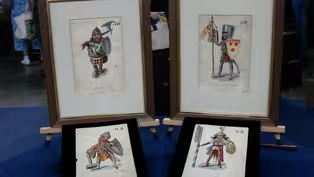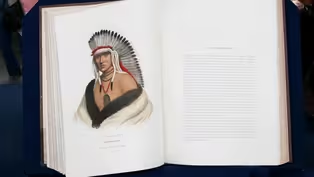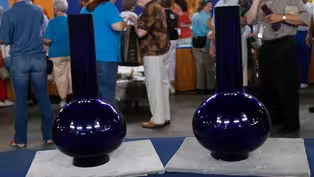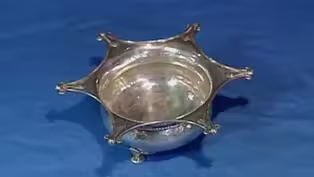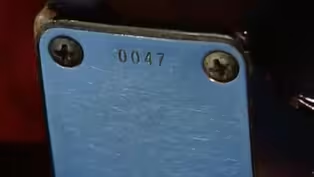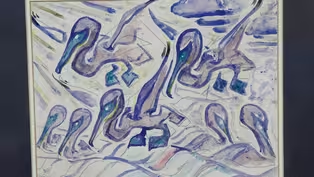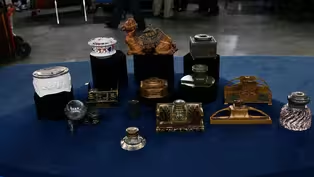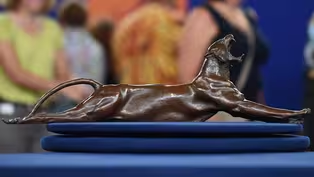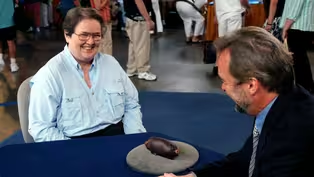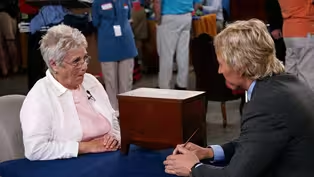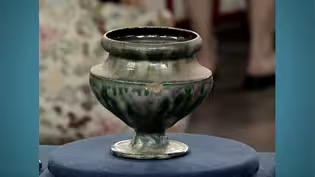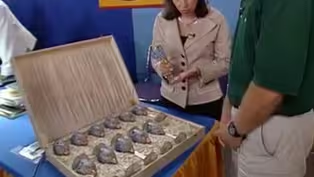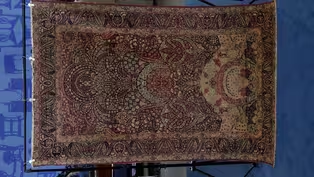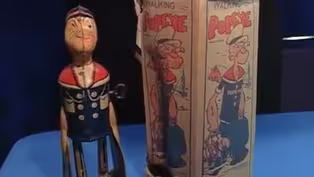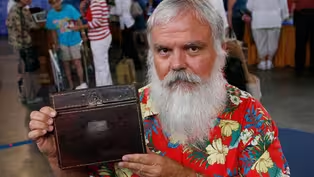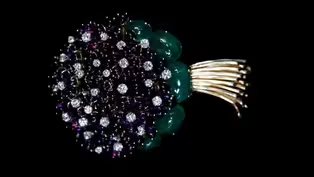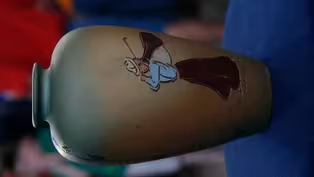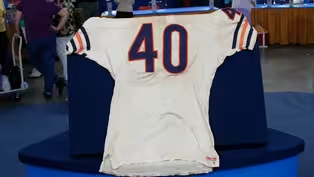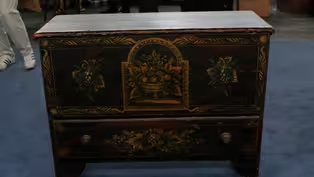

Vintage Mobile
Season 24 Episode 18 | 52m 30sVideo has Closed Captions
Revisit Alabama appraisals 14 years after ROADSHOW’s visit to Mobile, plus a $70K-$90K find!
Revisit Alabama appraisals 14 years after ROADSHOW’s visit to Mobile such as an “Indian Tribes of North America" set, a Gale Sayers game-worn jersey, and Chinese glass bottle vases from around 1775. Learn which is now valued at $70,000-$90,000!
Problems playing video? | Closed Captioning Feedback
Problems playing video? | Closed Captioning Feedback
Funding for ANTIQUES ROADSHOW is provided by Ancestry and American Cruise Lines. Additional funding is provided by public television viewers.

Vintage Mobile
Season 24 Episode 18 | 52m 30sVideo has Closed Captions
Revisit Alabama appraisals 14 years after ROADSHOW’s visit to Mobile such as an “Indian Tribes of North America" set, a Gale Sayers game-worn jersey, and Chinese glass bottle vases from around 1775. Learn which is now valued at $70,000-$90,000!
Problems playing video? | Closed Captioning Feedback
How to Watch Antiques Roadshow
Antiques Roadshow is available to stream on pbs.org and the free PBS App, available on iPhone, Apple TV, Android TV, Android smartphones, Amazon Fire TV, Amazon Fire Tablet, Roku, Samsung Smart TV, and Vizio.
Buy Now

ANTIQUES ROADSHOW 2025 Tour!
Enter now for a chance to win free tickets to ANTIQUES ROADSHOW's 2025 Tour! Plus, see which cities we're headed to!Providing Support for PBS.org
Learn Moreabout PBS online sponsorship♪ ♪ APPRAISER: That's a lot of shotgun.
(laughing): Yeah, it's a shotgun.
Okay.
Whew, goodness.
(laughs) That just takes my breath away.
I did good.
You did great.
(laughing) That's wonderful.
♪ ♪ CORAL PEÑA: "Antiques Roadshow" visited sweet home Alabama in 2006, and discovered tons of tasty treasures that had our appraisers bursting at the seams.
When you pulled this out, I almost lost it.
(laughs) PEÑA: Can you can guess if the value of these fantastic finds went up, down, or stayed the same?
Find out now in "Antiques Roadshow: Vintage Mobile."
MAN: Probably six years ago, my brother-in-law had seen an article that there was an auction up in Birmingham, and he wanted to know if I wanted to go over and look and try to buy a couple of shotguns.
Mm-hmm.
So I just rode over with him, had no intention of buying anything.
And they brought out these jars, and, and I wasn't even listening, really, to what they were talking about.
But what caught my interest is when the guy that was with the auctioneer says, "I'm going to excuse myself from the stage and I want to come and bid on these."
So it kind of piqued my curiosity, I guess.
So I waited until they were about to slam the hammer, and I raised my hand up, and the next thing I know, I'm the proud owner of these two blue jars, and my brother-in-law was kind of looking at me like I've lost my mind, and, yeah.
That happens at auctions.
(laughs) So you paid a couple of hundred dollars for them.
I think about $200.
And the first thing is, they're glass, and it's a very thick glass.
Yes.
And this particular shape is called a bottle form.
This kind of glass, this very intense, deep, dark color blue was created in China during the late 17th century and the early 18th century.
So these are Chinese.
Okay.
On the base, we see there's a square, and it's got four characters, and these four characters are important, because they tell us this was made during the reign of the Qianlong Emperor, all handmade, hand-polished, hand-blown, beautiful quality, very nice.
And it's really unusual to find a pair.
Pair.
So that's good.
(laughs) And the other thing that I noticed immediately is, there's a lot of chips on the base.
Yes.
And there's a big chip here on the top.
And you've watched the "Roadshow" enough to know that chips and cracks are... No good.
They're no good.
(laughs) It doesn't help anything.
On very thick pieces of glass like this, these chips, although they're unsightly, they don't really affect the stability and the overall integrity of the object.
Okay.
If they're shallow chips, those can often be polished out.
Right.
Now, I don't advocate doing that on this, because these are fairly deep chips.
Right.
And they certainly affect the value.
Yes.
And so I would say, at auction...
Right.
These would sell for $4,000 to $6,000.
Wow.
As they are now.
(laughs) Oh, no.
Okay?
That's a lot of shotguns.
Okay.
(laughing): Yes, it's a shotgun.
Okay.
Now, if they were not...
I hope my brother-in-law is watching.
I hope he's watching, too.
Now, if these were not chipped... Yep.
$12,000 to $18,000.
Wow.
Phew.
WOMAN: This was in my mother's family, it was my mother's grandmother's, and I've always loved it.
I had an uncle that used to sit on it.
APPRAISER: He used to sit on, on this.
And put his socks on every morning.
Okay.
And take his shoes off, I'm sure, at night.
Threw his dirty socks inside.
Inside there.
(laughing): Yes.
I thought I, I thought I smelled something.
I don't know, it's, like...
Yes, right, there you go.
There you go.
It's still got that scent.
But they say that you can see his little bottom end marks.
You know, with some imagination, I can imagine that.
(laughing): I don't know if that's... My mother always said that this was used as a document box.
This piece is made in the tradition of Philadelphia.
And Philadelphia cabinet makers, during the Federal period, when this was made-- 17... probably 90, okay, to about 1805-- were using inlay, like this light-wood stringing.
The piece itself is walnut with this light-wood inlay, which is probably holly.
These were made with a compass.
They took the compass, made the incision, and inlaid this.
Also, this banding, and coming down, this wonderful veneered skirt with flared French-style feet.
So you have all these Philadelphia characteristics.
Cabinet makers moved west and then down the Shenandoah Valley and then spread out, so they were making pieces in this style all through Virginia and Maryland.
So it very well could be Virginia.
Right.
It also could be western Pennsylvania.
You probably know that the hinges have been replaced, right?
Exactly.
And this has a little patch here.
Somebody let this drop, way before your uncle sat on it.
This piece of wood's been replaced right here.
The color in there is just great.
It's really been used.
And it probably was a document box, but you could store almost anything in it.
The fact that it's been used, the fact that, when you close it back up, the stringing on the side and the front matches the stringing that's down at the bottom, we know that lid's original, okay?
Right.
And when we turn it upside down, look at this wonderful oxidation here.
Look at that nice color.
A little chip in the plane that planed that board.
All that's what we love to see.
And do you see where this block fell off, this glue block?
Yes.
That attached the bottom board to the front.
And the witness mark matches between the back of the skirt and that bottom.
So that's, that's evidence, it's, like, that those were connected for 200 years or so.
So we know it's right.
We know it's a Federal piece.
I've talked to some of my colleagues.
We've got a consensus here.
Retail value on this little box, I would say, $7,000.
Ooh, thank you!
That's pretty neat.
I tell you, I don't think your uncle would sit on it anymore if he knew that, though, probably.
(laughs) No, I don't think so.
No, I don't think so.
A few of the reasons why I got excited about it were, was the Art Nouveau style of it all.
It's guilloché enamel in here, in this really great sort of plum color.
Mm-hmm.
Stones are demantoid garnets.
Right, right.
It would be trophy jewelry that would be worn to certain occasions.
The hunt balls.
Right, hunt balls, exactly.
Yes, yes.
Turn it around, and it is confirmed it is an Austrian hallmark, as well, on it.
It's a silhouette of my great-great-great- grandmother on a horse.
APPRAISER: Signed "Seville."
And Seville was an English silhouette-cutter.
And he came over here to this country and worked for a few years.
Do you see all these gold highlights?
That's very unusual.
APPRAISER: It's fairly common for the employees to make guitars.
They have employee Martins.
They're quite interesting, they're in very good shape.
MAN: Well, there are 12 goblets that were passed down through my family to me, and came out of Vicksburg, Mississippi.
APPRAISER: Did your family do any traveling?
Well, I think they went to Europe several times.
Mm-hmm.
But not any time lately.
Okay.
Well, I have a feeling that they may have been in Europe during the latter part of the 19th century or the early part of the 20th century, because that's about when, from when these glasses date.
I'm really bowled over by them, because to have a complete set of 12 in just perfect condition is very unusual.
And in the original fitted box.
Right, I thought that was neat, too.
It's really spectacular.
It's my belief that these were made in Bohemia.
Most likely, they were made by a company named Moser.
They did the finest work, this beautiful enameling that you see both on the goblet and on the foot.
The problem with actually identifying these is that there were a lot of other companies that were working in the area at the time.
Moser is the most famous, and they're considered to be the best.
If they're not Moser, I would value them on a retail basis at $300 apiece, and if they are Moser, they could have as much value as $500 apiece.
Oh, okay.
So we're talking a range from anywhere from $3,600 to $6,000.
They're very beautiful.
And it was great seeing them, and I just, my eyes just popped out of my head when I saw them.
Well, thank you.
WOMAN: My mom and I, when I was in high school about 14 years ago, we, just for fun, would go around, go to estate sales, and there was a house that had been closed up for a long time, and they were just having an estate sale.
So we went in.
We both love old photographs, and there was a box of old photographs, old newspaper clippings, and things like that.
And she recognized, in one of the pictures, that it was FDR and a bunch of famous people from Atlanta.
So she just put it back in the box and we walked up and said, you know, "How much?"
And they said, "Five dollars."
And so then we left and didn't really realize what was in it until we got home.
Well, once you started to go through it, I'm sure you started to realize that there were some pretty interesting things in it.
Yes.
Not the least of which is this very large archive of-- I've counted now 60 items-- telegrams, letters, and programs from Franklin Delano Roosevelt.
And it not only covers just one small narrow aspect of his life and career.
It's a very long span of time, from the 1920s-- before he was in elected life-- all the way to the White House.
They're all written to a man named John S. Cohen, who was trained in the Navy, became a press man, and then he became the editor and publisher of "The Atlanta Journal."
Okay.
And it was in Roosevelt's best interests to be in touch with him, because he could, obviously, in his position, get the word out about his ambitions.
So we start off in the '20s, and Roosevelt's talking here about wanting to write an editorial for the paper.
Then we follow Roosevelt into the late '20s, into '28, because he was, of course, going to Warm Springs, Georgia, for his recuperations.
And he's saying, "Apparently my election is confirmed by the latest return."
This is when he was running for New York governor.
Here's the invitation to the inauguration that was sent to Mr. Cohen.
Later, in 1932, during the presidential election, there was a vacancy in the Georgia seat of the Senate, and Cohen became the United States senator for Georgia.
And he was also the vice chairman of the Democratic National Committee.
Again, a great position for Roosevelt to utilize.
And then, finally, we find Roosevelt in the White House, 1933.
Now we're writing on White House stationery to "Dear Jack," talking now as the president.
You say you purchased the entire box for five dollars.
Right.
Just these items as an archive, very personal and over a long span of time, I would estimate at auction at $15,000 to $20,000.
Great!
That's wonderful.
So, thanks for bringing it in.
Thank you.
WOMAN: This is a piece of my great-grandfather's pottery, George Ohr, and he was the Mad Potter of Biloxi, Mississippi.
And how did you come about having these?
My mother is an Ohr.
She was Otto's daughter, and Otto was George's son.
And so she got five pieces.
I have a brother and a sister.
And this is the piece that I picked.
This is really gorgeous.
Thank you.
And I'm a big fan of George's work.
Oh, well, great.
I think he is the greatest ceramic artist, living or dead, in this country.
(chuckling): Oh, right, that's what they always say.
George was working out of Biloxi, Mississippi.
Right, and it's not that far over.
However, as you may know, most of your great-granddad's work went up to New Jersey.
Right.
Maybe some 10,000 pieces or so.
Yes.
With Mr. Jim Carpenter, who was an antique dealer, and that happened in the early 1970s.
Mm-hmm, mm-hmm.
Little was left beyond that.
Yes.
And the pieces that are actually descended from the family are very, very rare.
And these are called pre-Carpenterian pieces.
Right, I know.
Before Jim Carpenter.
And this is a large and beautiful piece.
George worked mostly hand-sized.
So anything that is bigger than hand-sized is very good.
It has the nice in-body twist here at the base.
Yeah.
He worked often in fairly dull, black glazes, brown glazes.
And this is so alive, it has a lot of mottling of the greens and raspberries.
There is a chip here and another smaller one on the inside here.
Mm-hmm.
But this is such a lovely pot that it still has some great value.
I want to show the mark here, which is the mark that we most often see on George's pots.
Yeah, the stamp.
The stamp here that says, "Biloxi, Mississippi."
This lovely piece, because of everything it has, because of the provenance, would easily be, at auction, $15,000 to $20,000.
Really?
Absolutely.
Oh, my goodness!
Oh, well, see, I just wanted to know for my own, you know, my own peace of mind what it was, because I never had it appraised before.
Never have.
Whoo!
Goodness!
(laughs) That just takes my breath away.
MAN: My oldest brother coached Little League up in Connecticut about 30 years ago.
And one of the kids on his team, his father was the public relations director for "Sports Illustrated."
Well, around that time, my brother opened up a sporting goods store, and the kid's father, out of appreciation for my brother's coaching efforts with his son, gave my brother a bunch of sports memorabilia to hang on the walls of the sporting goods store.
The sporting goods store didn't last but a few years, and when my brother moved down south, he brought all the sports memorabilia with him.
And I've been a lifelong Chicago Bears fan, so he gave me the jersey that we have here.
And this jersey belonged to Gale Sayers.
Gale Sayers.
And it was one of his away game jerseys.
And Gale Sayers was one of my heroes when I was a little boy.
The "Kansas Comet."
That's right.
One of the greatest and most exciting players of all time, in NFL history.
He was.
And one of the most tragic careers, cut short by a knee injury.
Yeah, he did.
And, actually, he was the youngest man ever elected to the Hall of Fame.
Oh, wow.
Here we have this jersey.
It's been in your possession for over 30 years.
Over 30 years, yes.
What have you been doing with it?
(chuckles) It's been folded up inside a box in, in my closet at my parents' house.
When I opened it up and my wife saw it, she was, like, "Is that your high school football jersey?"
And I, of course, told her no, and she was, like, "We just need to turn that into a rag and use it to wipe down some of the furniture."
But I persisted and told her, "No, no, no.
It's a famous football player's jersey."
She was just kind of, like, "Yeah, whatever."
(laughs) And then I put it back in the box, and it's been probably sitting in that box now, well, about 16 years.
16 years.
I'm glad she didn't turn it into a rag.
(chuckling): I am, too.
What you have here is, is, as you said, it's a Chicago Bears jersey.
It's from around 1969, 1970.
Okay.
Which were prime years for Gale Sayers.
Right.
It's picture-perfect, as far as tagging.
Tagging is very important when you're identifying jerseys and authenticating jerseys.
Okay.
Right down here, we have King O'Shea.
This was the manufacturer.
Right.
And King O'Shea manufactured the jerseys for the Chicago Bears during that time period.
You also have the size, 46.
That was Gale Sayers' size.
Wow.
Now, another thing, you look to see how much use a jersey has.
Now, as you can see, this jersey is pretty dirty.
Right.
There's a lot of sweat.
There's a lot of blood.
There's a lot of repairs, team repairs.
Right.
This jersey's been torn apart.
Right.
It's been through war, battles.
(chuckling): Oh, yeah.
More than one.
Sure.
This jersey's gone through game after game after game.
Right.
It's not like today, where a football player gets a new jersey every game.
Let me show you another one back here.
Big patch on the back.
You can see... Look at this, that's... Somebody tore that.
Right.
Right?
(both laugh) I mean, this has just been torn apart, and fixed.
Right.
And he wore it again.
Sure.
And again and again and again.
Now, it does have some issues, okay?
The zero on this sleeve right here is missing, okay?
That probably got torn off, too.
But that makes it better.
All these tears and rips and blood and sweat, that's what collectors want!
That's what everybody wants!
Yeah.
That's the history.
That's the NFL.
That's all those... That's the NFL, that's it.
That's it.
And it's all here.
Wow.
(chuckles) I mean, when you pulled this out, I almost lost it!
(laughs) The fact that you have the provenance you do, this jersey I would estimate at at least $20,000 to $30,000, Roger.
(laughing): Oh, my-- oh, my gosh!
I'm glad my wife didn't turn it into a rag.
I am, too, man!
(laughing): Man.
It's amazing!
It's awesome.
Oh, wow-- oh, wow.
(laughs) Wow.
(laughs) 20 to 30.
Yeah.
Is that at auction or is that... Yeah.
Man.
Do you know what you have here?
A pearwood tea caddy.
We open this up.
They were foil-lined to keep the tea fresh.
For years, they were always these little tea caddies, these pear-shaped tea caddies were always meant, and said that they were made in England.
But as the years have gone by, and the study on these, they believe they were made more in Holland.
The fruit ones, like the apple, the pear, and especially the melon, they're very hard to collect.
The Kalo Shop was part of an Arts and Crafts organization that was established in about 1897 in Chicago.
We have a brooch.
We have a bracelet with moonstones.
Mm-hmm.
And we have another brooch, which also has a pendant bail on it.
And in the center is a Wedgwood cameo.
We have this wonderful slot machine from 1934.
It's a nickel slot machine.
Slot machines were nickels, dimes, and quarters, and usually the quarters are the ones that are most collectible, because they have the biggest payout.
This is a Mills machine.
We can see "Mills Novelty Company."
(coin clinking) WOMAN: And it didn't pay.
(man laughs) MAN: I bought this 14 years ago from the original owner's oldest son.
He kept the original bill of sale and the one where he paid it off a year later.
APPRAISER: And that was in... July 28, 1956, on the bill of sale.
1956, and that was right here in Mobile?
Right in Mobile, right here in Mobile.
Okay.
Well, the easiest way to date a Fender Stratocaster-- obviously, it's an old one-- is to look at the serial number, and that's found on the back plate at the base of the neck.
And as we look at that, we can see it's 0047.
This is, literally, the 47th one made, excluding maybe a few prototypes.
That would actually place it in the year 1954.
It's nearly all original, with the exception of the knobs and the pickup covers.
And have you got any of the originals of those?
Right, they just kind of fell apart, though, they were so brittle.
Okay.
So I do have the pieces, though.
They do tend to decompose in the case.
It is ash, and ash was the original wood used on these.
It's just that it's cut perfectly on the quarter, which is very unusual.
Sometimes you see little rings of grain on it, but here, it's almost like a violin or an acoustic guitar.
You see these absolutely straight grain.
Right.
Any idea of the value?
I paid $3,000 for it.
$3,000?
I paid a lot of money for it.
14 years ago.
Mm-hmm.
Well, today, a 1954 Stratocaster would be valued at auction between $50,000 and $70,000.
(chuckles) And I think that not too much would be taken off just for the... You're kidding.
the knobs and the... the pickup covers being replacements.
But this is about as close as we're going to get to the original... Unbelievable.
Original thing.
Unbelievable.
Unbelievable.
Yeah, great piece.
Thanks for bringing it in today.
Oh, thank you very, very, very much.
Yeah, my pleasure.
MAN: I was the fortunate bystander, I guess you can say, in a liquidation of a large collection of Mount Vernon memorabilia that was known at that time as the Edmund Law Rogers Smith Collection.
And a descendant of the Custis line liquidated that large estate, much of which went back to Mount Vernon, especially the items that were known to have been at Mount Vernon during the occupancy by George and Martha Washington.
And I purchased this directly from the descendant.
I bought it in approximately 1981 to '83.
And I do not recall the price.
It was probably over $1,000, under $3,000.
The history behind this box is absolutely incredible.
I want to start off by pointing out that there's a silver plaque here.
The plaque says, "Presented by Marquis de Lafayette "to Eliza Parke Custis, who gives it to her beloved daughter, Eliza Law."
Who is the Marquis de Lafayette?
We all probably know.
Mm-hmm.
Who is Eliza Parke Custis?
The Marquis de Lafayette was one of our big allies and one of our liaisons with France during the Revolutionary War, and was very important in our winning the Revolutionary War.
And Eliza Parke Custis is the granddaughter of Martha Washington.
She was Jack's daughter, and Jack was Martha's son.
Correct.
Jack Custis.
Right.
When you open it up, this is...
This is basically a lap desk, a lady's writing desk, a traveling desk.
Here in the top, you have all the necessary tools: a little sander to brush on top of your inked paper.
This, a little inkwell.
You'd put your pens in here.
This may be where a sealing wax or something went.
And basically, this says that this was given to Eliza Parke Custis, and she's giving it to her daughter in 1823.
Same thing is more or less written on this much longer letter on the inside here.
This is on the kind of paper that one would expect to find in 1823.
And this is basically telling a little bit more about it, saying, "It was sent to me by the Marquis de Lafayette."
It's French.
Yeah.
There's no question about it.
I've showed it to several of the other appraisers who really know European items.
Mm-hmm.
The Marquis de Lafayette came here in 1777.
After the Revolutionary War, he went back to France.
Hm.
Then in 1824, at the request of Congress, President Monroe asked Lafayette to come to visit us.
Mm-hmm.
And he did that, and he was here for 14 months.
He visited all 24 states at the time.
But this box pre-dates his visit to the U.S., so it says, "This was sent to me from the Marquis."
So presumably this was sent from France to the United States.
The plaque probably wasn't on the box, or if it was on the box, it was not engraved.
Right.
You've done a lot of work on the genealogical connections between all the various family members.
Mm-hmm.
And I've got to say, from what you've shown me, the provenance of this box is absolutely ironclad.
I would place a pre-sale estimate of somewhere from $30,000 to $50,000.
(exhales) (voice breaking): Wow.
Well, it's not a bad investment for $1,500, $2,000, whatever.
Uh, indeed not, indeed not.
Wow.
Um... (sighs) I'll be very careful driving home.
(both laugh) WOMAN: I brought a Walter Anderson watercolor.
He is from Ocean Springs, Mississippi.
He lived and painted there.
What we have here is a very good example of one of his watercolors.
It has one of his favorite subjects, which is the pelican.
He's included a lot of the pencil drawing that he used in laying out the design, and so you see a lot of pencil work, which is very intriguing to collectors.
He was born around 1903 in New Orleans, and spent most of his life in Mississippi, except for a stint in Philadelphia, where he studied at the Pennsylvania Academy.
And then, of course, he comes back to Mississippi, and he, he actually starts out with prints.
He made linoleum wood block prints on a very large scale, larger than anyone else was doing at the time.
But he's really best known as being a painter and muralist, and he worked both in oil and watercolor.
Now, he was a bit eccentric.
He was somewhat reclusive, very much like George Ohr, the potter.
Wanted to be isolated from society, and loved the barrier islands, to the extent that he called himself "the islander."
And of course, the piece is signed here in the lower right with his monogram.
And I believe on the reverse, there is an inscription, is that right?
Right, yes, it has the date and that it was done on Horn Island.
And it was done in 1965, I think?
Yeah.
Five, I think.
(chuckling): I can't remember.
And that was about, that was the year he died, I think.
Yes, it was one of his last watercolors.
His work is somewhat rare today.
He was prolific, but you were telling me a story about what happened to, to his work as a result of a hurricane.
Yes, the family had the watercolors-- and pottery, too, I'm not sure-- stored in a vault.
Mm-hmm, mm-hmm.
But, unfortunately, Katrina smashed in the vault and, and... And ruined and destroyed.
And ruined a lot of things, yes.
Right.
I believe both of his brothers were potters, and they had the Shearwater Pottery.
Is that correct?
That's right, yeah.
And so there were paintings stored at that location.
Yes.
This was done on typing paper.
Mm-hmm.
And there were many, he'd done many of them.
And we looked through them and bought this one at Shearwater Pottery.
And what year was that?
1974.
How much did you pay?
$500.
A watercolor from the same date-- a different bird, not the pelican-- sold in December at a Southern auction for about $11,000.
Good.
This particular piece, because it does feature his favorite bird, it's in great condition, and it has wonderful history, coming directly from the pottery, I would judge, for insurance purposes, would probably be worth at least $15,000.
Oh, that's great.
And possibly a bit more.
Good.
WOMAN: I'm a physician, and when I moved to town, there was a very wise man who told me, "People are going to want to give you gifts.
You need to collect something."
So I said, "Well, pigs are a lot like people, so I'll collect pigs."
And the next day, he brought me three carved little pigs.
And that started it.
And how long ago was that?
(chuckling): 24 years ago.
No kidding?
Yeah.
And how many pigs have you got right now?
I have no clue.
Tell me how you came about this one.
My friend Nicki had a junk store.
I'd go down to her store to relax.
And these two friends of mine came in, and they, usually, they were fastidious, and they were covered with filth from the top of their head to the tip of their toe.
And they had been tearing down a shed, and they found this pig stuck in the wall.
And they brought it to Nicki to see if she would buy it from them.
And they wanted $200 for it, and Nicki doesn't spend money on anything.
So I bought it from them.
Then I felt guilty about it, like I'd done a stupid thing, but I liked the pig.
Well, I don't think you did a stupid thing.
This was made by an American pottery called the Anna Pottery.
And the Anna Pottery was founded in Anna, Illinois, in 1859.
And it was run by the Kirkpatrick family.
They made mostly ordinary, utilitarian stuff.
They made some unusual things, too, some figures, some jugs with snakes on.
Basically, they made folk pottery outside of their utilitarian ware.
And they made these little things, which are bourbon flasks.
As far as we know, they're the only pottery that made these things.
This particular one was probably made in the mid to late 1880s.
And it's quite typical of what we find in an Anna Pottery pig flask.
First of all, it's kind of whimsical, to the point of being a little bit, you might say, bawdy.
And a lot of the Anna Pottery stuff goes that way.
But that was not unusual in late 19th-century saloon culture.
(chuckling): Yeah.
And you can see on the back, there's an incised parallel line, which is a railway line it's depicting.
The ICRR is the Illinois Central Railroad.
There you see the word "Chicago," also, incised near the pig's snout.
It has a great-looking face.
Most of these were thrown away.
They were very inexpensive when they were new.
They were not really meant to be kept.
These are collected for lots of reasons.
And all the different reasons add up to value.
First of all, it's a pig, which is why you bought it.
There are a lot of pig collectors.
It's a piece of American stoneware.
It's a bourbon flask.
It's folk art.
It's bordering on the American Arts and Crafts movement.
It has a railroad connection.
I think you would expect at least $5,000 at auction.
(laughing): Are you... God!
Now I feel fine, and Nicki's going to go, "Oh, my goodness, what have I done?"
(laughs) I hope Nicki isn't watching.
(laughs) I think it could go as high as $7,000.
(laughs) You gotta be kidding me.
I am not kidding you.
(laughs): I cannot believe that pig is worth that much money.
Well, it's made out of mahogany with ebony and ivory keys.
And when you open it up, you have this lovely fitted sewing box with all the original tools in it.
It's probably French, 19th-century Palais Royal-- very rare box.
I've been collecting sewing items for about 25 years, and I've only seen three of these.
It was made by a friend of mine.
His name was Kramer.
All his rings had a fleur-de-lis on the side.
He never stamped them.
It is blue enamel and it is diamonds.
This is typical New York City ring.
(clattering) APPRAISER: Emily, you brought a, a cute little toy here today.
You want to tell me what, what it's from, where it's from, where you got it?
Well, my sister and I are working at my dad's house, my parents' house, which is also my grandparents' house, built in 1908, and it has the stuff from the family members, plus the aunts and uncles that didn't have children that brought things in.
And we really don't know anything about these toys.
We didn't even know it worked, because we didn't want to test it, so I'm, I'm glad it just... Well, we just, we just tested it, so we know it works.
I'm glad to know it works.
Let me tell you a little bit about it.
Okay.
You had-- it's done in the 1930s, made by Marx Company.
And the good thing about this toy is not the toy itself.
It's the box.
(laughs) Now, if you look at the toy, it's a wind-up.
It's Popeye carrying his parrot cages.
It's missing a pipe.
There's a little space there where a little metal pipe would go.
And the thing with that is, if... Toy people who collect this type of stuff know that you can get a replacement.
Uh-huh.
So that's not a major factor, you can get a replacement pipe.
The great thing about it is the box.
And in this case, the toy by itself in this condition may be worth about $150 to $250.
However, with the box, I would say it's about $400 to $600, meaning the box is actually, in this case, worth more than the toy.
A lot more toys than boxes.
What I would do with this one is keep the box in great shape, and you'll have a piece that's worth about $400 to $600.
(laughing): Maybe the, maybe the pipe's on the floor of the attic somewhere.
Search for it, see if you can find it.
WOMAN: The blanket chest was my grandfather's, and it's been in the family for as long as I can remember.
He's from Virginia and lived in Toms Brook.
Virginia.
Then my mother got it when he passed away.
Then it's passed down to me.
This is a paint-decorated Valley of Virginia blanket chest.
And most people date these 1850, which is an approximation.
It could be a little bit on one side or the other of 1850.
This is yellow pine, which is a really hard, resinous pine, and in the Valley of Virginia, a lot of the chests are made up there like that.
It's dovetailed construction, and it's basically what we in the trade would call a six-board chest.
But this is paint-decorated.
It has so many elements that are desirable about it.
First of all, it has this great mottled black over top of the red.
Mm-hmm, mm-hmm.
And on top, you got birds.
And on the front is probably the thing that sends me the most, is these horses.
This finish is a little shiny to be the original paint.
Right, right.
I think it's a clear finish that was put on it later.
Mm-hmm, mm-hmm.
But then I started thinking about that.
And I looked, and there's places that are alligatored like this, and the dry paint is right there underneath.
One of my fears would have been that somebody would have touched the paint up... Mm-hmm, mm-hmm.
Before they put the clear finish on.
Mm-hmm, yeah.
Look how the feet look.
Yeah, yeah, I know, yeah.
I know that's original.
That hadn't been painted over.
And look at this end.
It has more of that what we call alligatoring.
But the folk art people that collect folk art, they love a dry surface, and they love original paint.
Right.
If it were mine, I would insure it for $60,000.
(voice breaking): 60?
My mother will be thrilled.
Does that surprise you?
Yeah-- it really does.
It's amazing, it's really... Well...
I had no idea that it, you know, was anything like that.
I chose it out of my mother-in-law's estate about five years ago.
And it originally came from Shreveport, Louisiana, and that's all I know about the rug.
Well, the rug is a Persian rug made in what is now Iran.
And it's made around 1890 to 1900.
It's called a Laver Kirman.
It's an extremely fine rug.
And you'll notice that if you look at the back of the rug, it has very fine knots so that you can see the pattern very clearly.
This rug has approximately 300 knots per square inch.
So that's a tremendous amount of workmanship.
So, for this type of rug, it's important for it to have that degree of fineness, because they have attempted to do a very intricate design with all the flowers.
They like to refer to this as a millefleur design, or "a thousand flowers."
In this period, they were coming from a Victorian sensibility in terms of their design, but they were starting to be influenced by the Art Nouveau.
And so there's a very flowing quality to the design that is evocative of what was happening with the Art Nouveau decoration.
They were making these rugs for the Western market, and they were trying to make them so that they would appeal to that Western sensibility.
You'll notice that the red is a sort of burgundy or wine color.
That is actually an insect dye.
We talk a lot about natural dyes, which are dyes that are made from plant materials.
This is made from the cochineal insect that's found on cactus.
If you'll notice at the bottom, it's missing the outer border.
Here we have that red border.
Uh-huh.
And any time you're evaluating the condition of the rug, you want to make sure that that border goes around to the bottom and the top.
And you'll notice that it's lost that red border on the bottom and the top.
And oftentimes, what happened is, they would get a little bit of unraveling, and instead of fixing the unraveling, they would just even it off and overcast it.
It's sort of frayed on the edge.
The best thing would be to take it to a qualified repairer, who could rewrap it with wool so that it was secure.
If I were selling this in my gallery, I would sell it for about $8,500.
Okay.
If it had been able to retain the end borders, it would have been worth more in the realm of $12,000.
WOMAN: I found her at an estate sale in Pensacola, and she was in pieces, and so a friend of mine who makes dolls strung her again for me.
But she didn't want to do her eyes, because there seems to be a little problem with her eyes.
APPRAISER: Now, are you familiar with the Kewpie doll?
Yes.
This is not a Kewpie doll, but I wanted to talk about how this relates to the Kewpie.
Rose O'Neill, in 1909, started publishing in "Ladies' Home Journal" articles, drawings about the Kewpies, and then very shortly after that, started producing the Kewpie doll, which was a great success in this country.
And Kestner made most of the Kewpies.
Now, there was so much success with that, a lot of the other factories wanted to get in on that Kewpie image.
But it was copyrighted, so they had to start making similar items.
What you have is an Armand Marseille mold number 240 Googly Doll.
Armand Marseille was one of the largest factories in Germany.
They were in Köppelsdorf, which is in the Sonneberg area.
And I'll show you the mark here.
The 240, and the number underneath that is a 0.
And what that indicates is size.
Now, there would be a 1, which would be a larger size, 2, 3.
And there are also decreasing size.
So, sometimes you'll see a doll that's marked 1/0, or 2/0.
That means it's smaller than their 0 model.
Armand Marseille registered the mold number 240 in 1912.
So we have them making a Kewpie-type doll in 1912.
And the quality of this is just as good as the Kestner Kewpies.
And it has a lot of the Kewpie-esque features.
It has the large, side-glancing eyes, it has the impish mouth, and the topknot.
What it doesn't have that a Kewpie always has is wings.
Now, it has the wonderful bisque head that's in excellent condition, and it's a jointed five-piece composition body.
It came as a baby body, and it also came as this longer-legged toddler.
The toddler body is going to be a little bit more desirable than a, than a baby body.
A baby body, the legs would have been just bent legs.
You had mentioned the eyes.
One has slightly fallen in.
You can find a local doll hospital that will do that.
Can you tell me how much you paid at the estate sale?
I bought two dolls, and I'm thinking I paid, like, $175 to $200 for her.
It's terrific quality, in terrific condition.
An auction estimate would be easily $2,500 to $3,500.
Oh, really?
Yes.
With this nice toddler body, you know, it might bring $4,000.
Oh!
So...
It's not just simply a musical box.
It's also a phonograph.
And if we look in the drawer, we can see the turntable...
Yes.
And the tonearm and the sound box, which attach here and convert to being able to play 78 records.
It was made by Regina, which is the largest American musical box manufacturer.
As you know, it's a kiddush cup that's used for Jewish ceremonial purposes, for blessings.
Yeah.
And it very nicely has the prayer inscribed, blessing over the wine.
Made in the 20th century, so made probably in the last 50 years.
It's a very good piece of Newcomb.
This scenic Newcomb, the landscape, is a little bit rarer.
It was passed on to my husband from my father-in-law.
He lived in Marlborough, Wiltshire, and he told us that it was from a local silversmith.
That's all I know.
Oh, interesting.
I don't know if you're familiar with the Arts and Crafts movement in, in Great Britain, but it really, it's a little different than it is in the United States.
You have these elongated leaf tips and openings here in this beautiful hand-hammered surface that you can see, it just sort of shimmers all around it.
And it's actually made by one of the most important silversmiths of this period, a guy by the name of Omar Ramsden.
And Omar Ramsden actually has signed the piece and said, "Omar Ramsden fecit," which means "Omar Ramsden made this."
Okay.
It has a full set of marks.
It's actually made in London, as opposed to Wiltshire.
Okay.
And it's made in 1907.
They were a very important force in the Arts and Crafts movement from this time period.
If this appeared in one of my auctions, it would probably be around $2,000 or so.
Okay.
It's a beautiful piece of silver and just a great example of just a little jewel of Arts and Crafts silvermaking.
Okay.
WOMAN: They were in my husband's family.
They are original watercolor costume designs.
Uh-huh.
These wonderful costume designs are from the 19th century, by a French artist, Jules Maré.
And they were created for the famous, or infamous, early society the Cowbellion de Rakin Society.
Yes.
Let's take a look at the back.
Here's the reference number we have for the costume.
Uh-huh.
And sizes for the various people... Costume measurements, yes.
Uh-huh.
Costume measurements for who would be wearing the pieces.
Yes.
And this nice statement discussing the artist and also the Cowbellion group.
They got their name in 1830 from raiding hardware stores and waking people up with cowbells and rakes and hoes.
Exactly.
Costume designs are a very, very specific market.
They're in generally good condition, but you do have some foxing and staining.
Without the background, without the Mardi Gras connection, I'd probably value them between $300 and $500 apiece.
Uh-huh.
With the connection, however, I would estimate the collection at auction between $4,000 and $6,000.
Wow.
Yes.
(chuckles): That's terrific.
WOMAN: My husband and I cleaned out his aunt and grandmother's little Victorian house in Frankfort, Indiana, five years ago.
And this was just one of many pieces that we found.
And you know it's a piece of Weller pottery.
Yes, I do, mm-hmm.
Samuel Weller was in business in the 1880s.
They were making utilitarian pieces, but around 1900, when the Art Pottery and Arts and Crafts Movement were sweeping the country, they started making decorative ware, and that's what you have-- it's called Dickensware.
It's called Dickensware because in "Pickwick Papers," Charles Dickens named one of his characters Sam Weller.
Oh.
And so Samuel Weller named one of his pottery lines Dickensware.
And originally, Dickensware was an underglaze-painted line with flowers, primarily.
Sometimes portraits, but mostly flowers.
But Dickensware II was like this type, which is sgraffito.
The design is outlined with a sharp tool...
Yes.
That reveals the clay underneath.
This is the company mark, which says, "Dickensware, Weller," underneath it.
What's also interesting, though, is the subject matter.
They made a lot of things, but they did a number of pieces with golfers-- usually men golfers-- on them.
The best buyers of this sort of ware are people who buy golf memorabilia.
(laughs): Oh, really?
Conservatively, at auction, because of the female golfer, it would be worth about $1,500 to $2,000.
(laughing) So... Oh!
My husband will be thrilled.
WOMAN: I found it at an estate sale in south Mississippi.
I saw it, thought it was absolutely beautiful.
I paid $5,400.
It's a Verdura brooch.
According to the box that it was in, it's from 1954.
I'm an old-time jeweler, and I knew Mr. Verdura.
He passed away in 1978, but he made some fabulous, fabulous jewelry.
And he loved color.
He loved insects, he loved flowers.
And he was a Fifth Avenue upstairs jeweler.
That to me is like the top of the line.
You have a Verdura flower pin here.
In this particular piece, you have diamonds, which are all full-cut, all set in platinum.
You have emeralds, which are South American emeralds, which are green.
It's 18-karat gold, and your amethysts are of the top quality of Uruguayan amethyst.
They have that purple-blue in them.
And Verdura, when he made this piece, he made it so beautifully.
In the back here, all these little set screws come apart.
Yes.
So you can take the flowers off, repair it, and put it back together again.
Oh, how interesting!
It's very easy for a jeweler to repair this, if it ever breaks.
But he made it like a piece of rock.
Okay.
A piece like this, if it came up for auction and we advertised it right, could easily sell anywhere from $25,000 to $35,000.
(gasps): Oh, my goodness!
Oh, wow.
I've got these three volumes of the McKenney and Hall Indians.
A dear, dear friend of mine bought these in Natchez, Mississippi, in 1964.
And the people that were selling them, it was like a garage sale, and they wanted $100 a book, and she talked them down, bought all three of them for $250.
So I saw them a number of years ago, and I always loved them, loved them, loved them, and kept after her, after her.
So finally she said she would sell them to me.
This was in 1994.
But she wanted $1,000 a volume.
And I said, "What the heck?"
So I went and I got the money and I bought them.
I just thought it was very good-looking, the size, the color, the print, and everything.
I just thought they were wonderful, had to have them.
Well, you are right.
This is a very good-looking book.
This is an important book for two reasons.
It's an important example of American bookmaking, American printmaking, in the tradition of the big Audubon folios.
I mean, this is 19th-century American lithography at its best.
But it's also an important piece of American history.
This book is put together by two men, Thomas McKenney and James Hall.
And Thomas McKenney worked for the Department of War in the 1830s.
And part of his job was to negotiate treaties with the Native Americans who would come to Washington to sign treaties.
And he thought up the idea of having the representatives, the chiefs, the tribal leaders, pose for portraits in oil while they were in Washington.
So he put together this tremendous collection of paintings of Native Americans.
And it was really one of the first and best records of what those individuals looked like, what their costumes were like, what they brought with them to Washington to negotiate the treaties.
Outstanding.
He actually got so involved in curating this collection of portraits, that he lost his job with the Department of War.
So then he got involved in publishing, and he took those paintings, and he had these gorgeous lithographs made, and this is a beautiful example of it here, and published these books by subscription.
It came out in three volumes.
You have all three volumes here.
And there are 120 illustrations of Native American leaders of various tribes of the time.
What makes this book especially rare and valuable is that all of those original paintings were donated to the Smithsonian, and in 1865, many were destroyed in a fire.
Oh, my.
All we have left of those records... Are these... ...are these lithographs in this three-volume set.
It's been reprinted many, many times, but you've got the first edition.
You've got it in its original form.
This is the original cloth cover for the book, which means it's not been rebound or cut down.
So they're just gorgeous.
The last couple of times a set this nice sold at auction, sold for about $70,000.
Oh, my goodness!
So you're-- I would put an auction estimate on this three-volume set of $70,000 to $90,000.
Oh, goodness!
Thank you.
Well, thank you for bringing it in.
I love it.
I did good.
You did great.
(laughing): That's wonderful.
Oh, great!
That's good.
Very good.
PEÑA: You're watching "Antiques Roadshow: Vintage Mobile."
PEÑA: And now it's time for the Roadshow Feedback Booth.
My wife bought this for me.
I was going to get a boat motor, but this is what I got instead.
I was really excited to learn a lot about it, and they told me lots about it.
Said it was worth about $500.
If we could identify who it was made from, it'd be worth $2,000.
But I loved coming to the Roadshow.
I had so much fun today.
People got a lot of stuff here.
This is Danny O'Day, and we just found out that Danny O'Day is worth about $100.
I've got the album and everything.
Thanks, Grandma, for giving it to me for Christmas over 30 years ago.
Thank you!
We had a great time at "Antiques Roadshow," and we saw Mr. Farmer, and he said that if we... We can either hang our pictures like this, or if we're mad at each other, we can hang our pictures like this.
We have a 1934 guitar made in Hartselle, Alabama.
And this is my baby, modern-day treasure, signed by the Keno brothers.
And almost half of the crew.
These Suwannee prints were in my mother's nursery.
She said they wouldn't be worth anything, and they're worth $150 apiece-- go, Mama!
I brought my husband's grandmother's ring with me that I was given.
It's worth $14,000 to $16,000.
(laughing): I'm, like, "Yay!"
Thank you.
PEÑA: Thanks for watching.
See you next time on "Antiques Roadshow."
Appraisal: 1837 Mardi Gras Costume Designs
Video has Closed Captions
Clip: S24 Ep18 | 1m 30s | Appraisal: 1837 Mardi Gras Costume Designs (1m 30s)
Appraisal: 1838-1844 “History of the Indian Tribes of US"
Video has Closed Captions
Clip: S24 Ep18 | 3m 29s | Appraisal: 1838-1844 “History of the Indian Tribes of US" (3m 29s)
Appraisal: 18th-Century Chinese Glass Bottle Vases
Video has Closed Captions
Clip: S24 Ep18 | 3m 5s | Appraisal: 18th-Century Chinese Glass Bottle Vases (3m 5s)
Appraisal: 1907 Omar Ramsden Silver Dish
Video has Closed Captions
Clip: S24 Ep18 | 1m 15s | Appraisal: 1907 Omar Ramsden Silver Dish (1m 15s)
Appraisal: 1954 Fender Stratocaster
Video has Closed Captions
Clip: S24 Ep18 | 1m 56s | Appraisal: 1954 Fender Stratocaster (1m 56s)
Appraisal: 1965 Walter Anderson Watercolor
Video has Closed Captions
Clip: S24 Ep18 | 2m 50s | Appraisal: 1965 Walter Anderson Watercolor (2m 50s)
Appraisal: 19th-20th C. Inkwell Collection
Video has Closed Captions
Clip: S24 Ep18 | 1m | Appraisal: 19th-20th C. Inkwell Collection (1m)
Appraisal: A.H. Huntington "Yawning Tiger" Bronze
Video has Closed Captions
Clip: S24 Ep18 | 35s | Appraisal: A.H. Huntington "Yawning Tiger" Bronze (35s)
Appraisal: Anna Pottery Pig Bourbon Flask, ca. 1885
Video has Closed Captions
Clip: S24 Ep18 | 3m 28s | Appraisal: Anna Pottery Pig Bourbon Flask, ca. 1885 (3m 28s)
Appraisal: Armand Marseille google-eyed Doll, ca. 1915
Video has Closed Captions
Clip: S24 Ep18 | 2m 57s | Appraisal: Armand Marseille google-eyed Doll, ca. 1915 (2m 57s)
Appraisal: Federal Walnut Document Chest
Video has Closed Captions
Clip: S24 Ep18 | 2m 38s | Appraisal: Federal Walnut Document Chest (2m 38s)
Appraisal: Franklin D. Roosevelt Archive
Video has Closed Captions
Clip: S24 Ep18 | 2m 54s | Appraisal: Franklin D. Roosevelt Archive (2m 54s)
Appraisal: George Ohr Vase, ca. 1900
Video has Closed Captions
Clip: S24 Ep18 | 2m 40s | Appraisal: George Ohr Vase, ca. 1900 (2m 40s)
Appraisal: Late 19th Century Bohemian Glass Wine Goblets
Video has Closed Captions
Clip: S24 Ep18 | 1m 32s | Appraisal: Late 19th Century Bohemian Glass Wine Goblets (1m 32s)
Appraisal: Painted Blanket Chest, ca. 1850
Video has Closed Captions
Clip: S24 Ep18 | 2m 24s | Appraisal: Painted Blanket Chest, ca. 1850 (2m 24s)
Appraisal: Persian Lavar Kirman Pictorial Rug, ca. 1900
Video has Closed Captions
Clip: S24 Ep18 | 2m 38s | Appraisal: Persian Lavar Kirman Pictorial Rug, ca. 1900 (2m 38s)
Appraisal: Popeye Tin Toy & Box, ca. 1915
Video has Closed Captions
Clip: S24 Ep18 | 1m 38s | Appraisal: Popeye Tin Toy & Box, ca. 1915 (1m 38s)
Appraisal: Presentation Lap Desk, ca. 1795
Video has Closed Captions
Clip: S24 Ep18 | 4m 4s | Appraisal: Presentation Lap Desk, ca. 1795 (4m 4s)
Appraisal: Verdura Flower Brooch, ca. 1954
Video has Closed Captions
Clip: S24 Ep18 | 1m 49s | Appraisal: Verdura Flower Brooch, ca. 1954 (1m 49s)
Appraisal: Weller Dickensware II Vase, ca. 1905
Video has Closed Captions
Clip: S24 Ep18 | 1m 37s | Appraisal: Weller Dickensware II Vase, ca. 1905 (1m 37s)
Appraisal: Gale Sayers Game-worn Jersey, ca. 1969
Video has Closed Captions
Clip: S24 Ep18 | 4m 14s | Appraisal: Gale Sayers Game-worn Jersey, ca. 1969 (4m 14s)
Appraisal: Painted Blanket Chest, ca. 1850
Video has Closed Captions
Clip: S24 Ep18 | 34s | Appraisal: Painted Blanket Chest, ca. 1850 (34s)
Providing Support for PBS.org
Learn Moreabout PBS online sponsorshipSupport for PBS provided by:
Funding for ANTIQUES ROADSHOW is provided by Ancestry and American Cruise Lines. Additional funding is provided by public television viewers.


